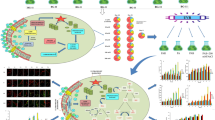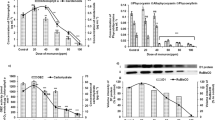Abstract
Atrazine (ATZ) is a commonly used herbicide that has recently come under scrutiny due to potential environmental toxicity and contamination. In this study, we found that the administration of ATZ indeed leads to reduction of photosynthesis and oxidative stress in Phaeodactylum tricornutum at the treated doses higher than 100 μg L−1 after 48 h. We further explored the effect of ATZ on photosystem II (PSII) and gene expression of electron transport chain. Collectively, our results may suggest that ATZ entered the chloroplasts in alga depending on ATZ’s liposolubility and directly attacked on the electron transport chain, especially PSII, contributing to reactive oxygen species (ROS) burst. The increasing ROS could act as signals to induce or disturb the expression of photosynthesis-related genes, resulting in the imbalance of antioxidation and pro-oxidation in the alga.







Similar content being viewed by others
References
Ali MB, Hahn EJ, Paek KY (2005) Effects of temperature on oxidative stress defense systems, lipid peroxidation and lipoxygenase activity in Phalaenopsis. Plant Physiol Bioch 43:213–223
Assaf NA, Turco RF (1994) Influence of carbon and nitrogen application on the mineralization of atrazine and its metabolites in soil. J Pest Sci 41:41–47
Besplug J, Filkowski J, Burke P, Kovalchuk I, Kovalchuk O (2004) Atrazine induces homologous recombination but not point mutation in the transgenic plant-based biomonitoring assay. Arch Environ Contam Toxicol 46:296–300
Buster HR (1990) Atrazine and other s-triazine herbicides in lakes and in rain in Switzerland. Environ Sci Technol 24:1049–1058
Chalifour A, Juneau P (2011) Temperature-dependent sensitivity of growth and photosynthesis of Scenedesmus obliquus, Navicula pelliculosa and two strains of Microcystis aeruginosato the herbicide atrazine. Aquat Toxicol 103:9–17
Chen Q, Zhang M, Shen S (2010) Effect of salt on malondialdehyde and antioxidant enzymes in seedling roots of Jerusalem artichoke (Helianthus tuberosus L.). Acta Physiol Plant 33:273–278
Christof K, Ulrich S (2008) Complementary PS II quantum yields calculated from simple fluorescence parameters measured by PAM fluorometry and the saturation pulse method. PAM Appl Notes 1:27–35
Cid A, Concepcih H, Enrique T, Julio A (1995) Copper toxicity on the marine microalga Phaeodactylum tricornutum: effects on photosynthesis and related parameters. Aquat Toxicol 31:165–174
Deng CN, Zhang DY, Pan XL, Chang FQ, Wang SZ (2013) Toxic effects of mercury on PSI and PSII activities, membrane potential and transthylakoid proton gradient in Microsorium pteropus. J Photochem Photobiol B 127:1–7
Florita F, Catherine JC, Philip M, Andrew PN (2013) Phytotoxicity of four photosystem II herbicides to tropical seagrasses. PloS One 8, e75798
Flynn K, Spellman T (2009) Environmental levels of atrazine decrease spatial aggregation in the fresh water mussel, Elliptio complanata. Ecotoxicol Environ Saf 72:1228–1233
Gao YP, Fang JG, Zhang JH, Ren LH, Mao YZ, Li B, Zhang ML, Liu DH, Du MR (2011) The impact of the herbicide atrazine on growth and photosynthesis of seagrass, Zostera marina (L.), seedlings. Mar Pollut Bull 62:1628–1631
Graymore M, Stagnitti F, Allinson G (2001) Impacts of atrazine in aquatic ecosystems. Environ Int 26:483–495
Hirschberg J, McIntosh L (1983) Molecular basis of herbicide resistance in Amaranthus hybridus. Science 222:1346–1349
Huber W (1993) Ecotoxicological relevance of atrazine in aquatic systems. Environ Toxicol 12:1865–1881
Jeannette AW, Marie ED, Michael H (2007) Atrazine induced species-specific alterations in the subcellular content of microalgal cells. Fulton Pestic Biochem Physiol 87:47–53
Jensen KIN, Stephenson GR, Hunt LA (1977) Detoxification of atrazine in three gramineae subfamilies. Weed Sci 25:212–220
Jursinic P, Stemler A (1983) Changes in [14C] atrazine binding associated with the oxidation–reduction state of the secondary quinone acceptor of photosystem II. Plant Physiol 73:703–708
Kumar KS, Dahms HU, Lee JS, Kim HC, Lee WC, Shin KH (2014) Algal photosynthetic responses to toxic metals and herbicides assessed by chlorophyll a fluorescence. Ecotoxicol Environ Saf 104:51–71
Laisk A, Oja V, Rasulov B, Eichelmann H, Sumberg A (1997) Quantum yields and rate constants of photochemical and nonphotochemical excitation quenching (experiment and model). Plant Physiol 115:803–815
Leilan B, Richard B, Ryan P, Keith S, Mark H (2013) Sensitivity of a green alga to atrazine is not enhanced by previous acute exposure. Environ Pollut 181:325–328
Livak KJ, Schmittgen TD (2001) Analysis of relative gene expression data using real-time quantitative PCR and the 2−ΔΔCt method. Methods 25:402–408
Lu YC, Yang SN, Zhang JJ, Zhang JJ, Tan LR, Yang H (2013) A collection of glycosyl transferases from rice (Oryza sativa) exposed to atrazine. Gene 531:243–252
Macinnis CMO, Ralph PJ (2003) Short-term response and recovery of Zostera capricorni photosynthesis after herbicide exposure. Aquat Bot 76:1–15
Nathalie V, Eggen RIL, Escher BI, Jerome K, Nathalie C (2008) Effect of pulse herbicidal exposure on Scenedesmus vacuolatus: a comparison of two photosystem II inhibitors. Environ Toxicol Chem 27:1399–1407
Nemat AMM (1995) Glutathione regulation of glutathione S-transferase and peroxidase activity in herbicide-treated Zea mays. Plant Physiol Biochem 33:185–192
Nemat AMM (2000) The influence of naphthalic anhydride and 1-aminobenzotriazole on maize resistance to herbicides: a possible role for glutathione S-transferase in herbicide persistence and detoxification. Agric Med 130:18–26
Nemat AMM, Hassan NM (2006) Changes of antioxidants levels in two maize lines following atrazine treatments. Plant Physiol Biochem 44:202–210
Owens TG (1986) Light-harvesting function in the diatom Phaeodactylum tricornutum II. Distribution of excitation energy between the photosystems. Plant Physiol 80:739–746
Qian HF, Chen W, Sheng GD, Xu XY, Liu WP, Fu ZW (2008a) Effects of glufosinate on antioxidant enzymes, subcellular structure, and gene expression in the unicellular green alga Chlorella vulgaris. Aquat Toxicol 88:301–307
Qian HF, Sheng GD, Liu WP, Lu Y, Fu ZW (2008b) Inhibitory effects of atrazine on Chlorella vulgaris as assessed by real-time polymerase chain reaction. Environ Toxicol Chem 27:182–187
Qian HF, Pan X, Chen J, Zhou D, Chen Z, Zhang L, Fu Z (2012) Analyses of gene expression and physiological changes in Microcystis aeruginosa reveal the phytotoxicities of three environmental pollutants. Ecotoxicology 21:847–859
Qian HF, Takuma T, Tsuyoshi E, Fumihiko S (2014) The PGR5 and NDH pathways in photosynthetic cyclic electron transfer respond differently to sub-lethal treatment with photosystem-interfering herbicides. J Agric Food Chem 62:4083–4089
Richard AB, Joshua RA, John RP, Alan JH (2012) Recovery of photosynthesis and growth rate in green, blue-green, and diatom algae after pulsed exposure to atrazine. Environ Toxicol Chem 31:2572–2581
Ross J (2005) The ecotoxicological effects of photosystem II herbicides on corals. Mar Pollut Bull 51:495–506
Ross JJ, Ailsa PK (2003) Phytotoxicity of photosystem II (PSII) herbicides to coral. Mar Ecol Prog Ser 261:149–159
Shimabukuro RH, Frear DS, Swanson HR, Walsh WC (1970) Glutathione conjugation: atrazine detoxification mechanism in corn. Plant Physiol 46:103–107
Solomon KR, Baker DB, Richards RP, Dixon KR, Klaine SJ, La Point TW (1996) Ecological riskassessment of atrazine in North American surface waters. Environ Toxicol Chem 15:31–76
Song Y, Zhu LS, Xie H, Wang J, Wang JH, Liu W, Gong XL (2009) Effects of atrazine on DNA damage and antioxidative enzymes in Vicia faba. Environ Toxicol Chem 28:1055–1062
Ulrich S, Christof K (2008) New accessory for the Dual-PAM-100: the P515/535 module and examples of its application. PAM Appl Notes 1:1–10
USEPA (United States Environmental Protection Agency) (2011) Atrazine ecological exposure monitoring program data. Document ID: EPA-HQ-OPP-2003-0367-0205, Docket ID: EPA-HQ-OPP-2003-0367
Vallotton N, Eggen RI, Escher BI et al (2008) Effect of pulse herbicidal exposure on Scenedesmus vacuolatus: a comparison of two photosystem II inhibitors. Environ Toxicol Chem 27:1399–1407
Wang X, Li J, Xing H, Xu S (2011) Review of toxicology of atrazine and chlorpyrifos on fish. J Northeast Agric Univ 18:88–92
Wei Y, Zhu N, Michel L, Wang JY, Qian HF, Fu ZW (2014) Copper toxicity to Phaeodactylum tricornutum: a survey of of the sensitivity of various toxicity endpoints at the physiological, biochemical, molecular and structural levels. Biometals 27:527–537
Weiner JA, De Lorenzo AE, Fulton MH (2004) Relationship between uptake capacity and differential toxicity of the herbicide atrazine in selected microalgal species. Aquat Toxicol 68:121–128
Xie J, Bai XC, Li YL, Sun CC, Qian HF, Fu ZW (2014) The effect of glufosinate on nitrogen assimilation at the physiological, biochemical and molecular levels in Phaeodactylum tricornutum. Ecotoxicology 23:1430–1438
Yang H, Duan S (2010) The ecological toxic effects of dibutyl phthalate on Phaeodactylum tricornutum. Ecol Environ Sci 19:2155–2159 (in Chinese)
Zaefyzadeh M, Quliyev RA, Babayeva SM, Abbasov MA (2009) The effect of the interaction between genotypes and drought stress on the superoxide dismutase and chlorophyll content in durum wheat landraces. Turk J Biol 33:1–7
Zhang JJ, Zhou ZS, Song JB, Liu ZP, Yang H (2012) Molecular dissection of atrazine-responsive transcriptome and gene networks in food crop rice by high-throughput sequencing. Hazard Mater 219–220:57–68
Acknowledgments
This work is a contribution of the Program for Natural Science Foundation of China (21277125), Zhejiang Provincial Natural Science Foundation of China (LR14B070001), and the Program for Changjiang Scholars and Innovative Research Team in University (IRT13096). The authors thank the reviewer, Asad from College of Biological and Environmental Engineering, Zhejiang University of Technology.
Conflict of interest
The authors declare that they have no conflict of interest.
Author information
Authors and Affiliations
Corresponding author
Additional information
Responsible editor: Philippe Garrigues
Rights and permissions
About this article
Cite this article
Bai, X., Sun, C., Xie, J. et al. Effects of atrazine on photosynthesis and defense response and the underlying mechanisms in Phaeodactylum tricornutum . Environ Sci Pollut Res 22, 17499–17507 (2015). https://doi.org/10.1007/s11356-015-4923-7
Received:
Accepted:
Published:
Issue Date:
DOI: https://doi.org/10.1007/s11356-015-4923-7




